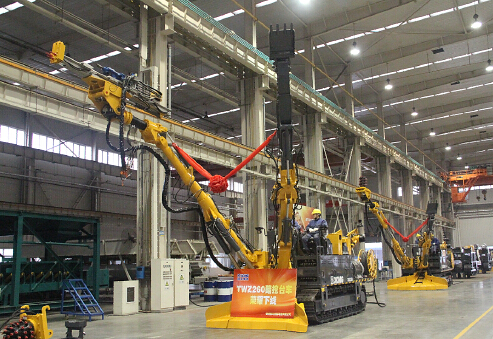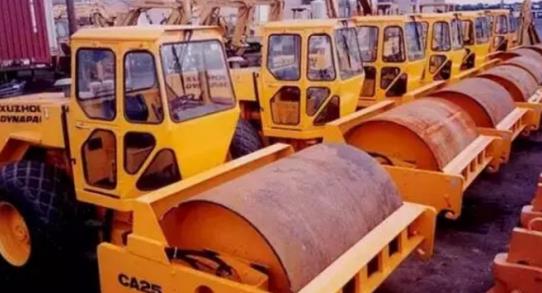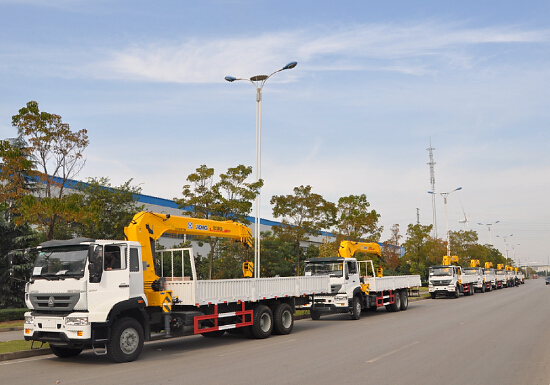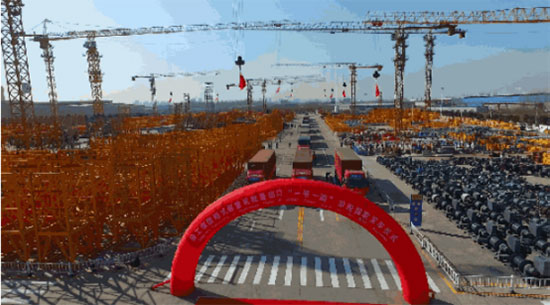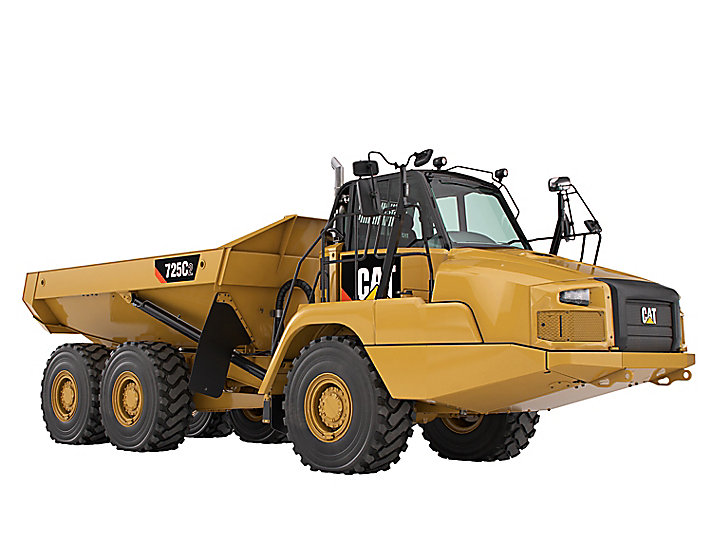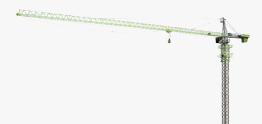

Press contact:
Terex Cranes Global Marketing
Press & Public Relations
E-mail: info.cranes@terex.com
RESCUING A DERAILED TRAIN
Liguria, Italy, May 2014 – A few months ago, every newscast in Italy was showing pictures of several Terex® mobile cranes that returned an Intercity 660 locomotive and railcars back to their rails. The train had derailed on the way to the Italian town of Andora due to a landslide near the cliffs of Capo Mimosa, on the southwestern Ligurian coast. Fortunately, there were no injuries. Unfortunately, the place where the train derailed couldn't have been worse: vertical rock on one side and nothing but water on the other. Removing the train in this location seemed a logistical nightmare. To achieve this, lifting specialist company Vernazza Autogrù was hired by Rete Ferroviaria Italiana (RFI) [the Italian Railway Network]. The operation was spectacular, but what was even more spectacular was the way it was planned and executed.
Details of the operation
“The first survey was done in conjunction with the RFI technicians on January 23rd, as soon as the mayor gave us permission to enter the area,” says Diego Vernazza, one of the owners of Vernazza Autogrù. “Next, the railroad authorities asked us for feasible proposals for recovering the train intact. Our technical department set to work designing a range of solutions, with complexity and cost effectiveness as key variables.”
Ultimately, an approach was selected that required minimum preliminary work near the cliff and on the tracks to minimize impact of weather during the preparations. “Safety and time requirements were the priorities that we shared with the RFI managers. However, it was clear that the urgency factor could not override certain key variables, starting with the weather conditions and their effect on the ocean currents,” says Vernazza.
This brings us to the solution devised by Vernazza Autogrù. “The idea was to build a ‘crane barge’ – a sort of self-submerging dock that could transport the cranes to a position close to the cliff – along with a module that could be outfitted in accordance with specific safety and stability requirements and supplemented by ballast compartments that would be necessary to maintain a constant balance during navigation and mooring. The fully equipped dock was 90 meters long and 27 meters wide, with an overall capacity of 11,700 tonnes,” Vernazza explains.
“We had to reinforce the basic structure of the floating dock, because at first, the capacity of the module wasn’t sufficient enough to support the weight of the vehicles. Once the barge was properly reinforced, we secured the Terex AC 700 to the floating dock to form an integral structure with the floating dock. This crane was the one that executed most of the heavy lifting required. After this was set up, we got the official Italian Marine Registry [“Registro Italiano Navale”] (RINA) certification that we needed for the navigation phase and for the subsequent lifting activities,” continues Vernazza.
After loading all the cranes on the floating dock and sailing to where the derailment took place, Vernazza Autogrù positioned the crane barge and moored it near the Capo Mimosa cliff. “While the barge was being outfitted in the area of the port of Genoa dedicated to assembly activities, we sent an initial operations team to Andora with the task of securing the locomotive and the railroad car and creating the attachment points that we needed in order to lift the train. At the same time, a team of divers surveyed the seabed within the area of 5,000 square meters where the floating dock would be moored. The divers used a high-tech depth-finder to identify the critical points,” Vernazza explains.
With the aid of a dive team and two tugboats, the barge was towed into position and moored in a spot almost touching the base of the cliff. “At this point we started the complex part of the operation,” Vernazza continues. “To ensure the stability of the locomotive, we lifted and moved a Terex AC 100/4 L all terrain crane from the barge to the railroad, coordinating the timing of the crucial lifting operation with the greatest possible precision.”
After the slings were installed on the locomotive, the mobile cranes performed a combined lifting action in order to move the train. “The risk was that the locomotive might become separated from the rest of the rail cars,” Vernazza remarks. “However, the locomotive and the first car behind it actually formed a single unit. During the derailment, the bumpers had penetrated deeply into the rail car, and the plates were solidly jammed together. After making several unsuccessful attempts with a thermal lance, we used multiple air-cushions, each with a thrust of 35 tonnes, to extract the locomotive from the rail car.”
When everything was ready, the locomotive was lifted and set in its proper position on the tracks. Approximately 90 tonnes of steel were placed on the rail line, ready for the final trip to the railyard with the rescue engines moving the formation of the Intercity train.
The equipment that made it happen
The “heavyweights” at the core of the operation were Terex all terrain cranes; a Terex AC 700 all terrain crane, the unquestioned star of the operation: a 700 tonne capacity class machine configured for this task with main boom, SSL, and a 180-tonne counterweight; and a 100 tonne capacity Terex AC 100/4 L and a 140 tonne capacity AC 140 crane configured with main boom and a full set of counterweights.
As Diego Vernazza explains: “The Vernazza Autogrù fleet includes a variety of Terex cranes. The ones that we used for the Andora operation were chosen because they provide outstanding lifting power with ease of mobilization, which was a critical aspect for this job. The AC 100/4L all terrain crane in particular offered great capacities in a very light and compact package. It was one of our most complex projects up to date, and we couldn't have made it without these cranes.”
About the Terex® AC 700 all terrain crane
The Terex® AC 700 all terrain crane is one of the most powerful telescopic cranes in the 700-tonne capacity class that can be transported together with its complete 60-meter (196ft) main boom within an axle load of 12 metric tons. An enormous increase in lifting capacity, especially when working with steep boom positions, is achieved with the sideways superlift (SSL) system. The crane’s star-type outriggers reduce system deformation and provide exceptional lifting capacities with a support base measuring 12.2 x 12.4 meters. The crane combines large lifting capacities with a compact undercarriage length of only 18.60 meters. A state-of-the-art engine and a fully-automatic transmission provide the crane with its outstanding power, and its four drive axles (3+4 and 8+9) feature differential locks. The crane’s unmatched maneuverability makes it versatile at the construction site: eight of its axles are steerable (one to five and seven to nine). An automatic leveling mechanism is also available. The crane can be configured with a luffing fly jib measuring 24 to 96 meters. With only a few steps, the luffing fly jib can be rearranged into a rigid fly jib with a length of 20 to 50 meters, or, as a light system with a length of 6 to 36 meters.
About the Terex® AC 100/4L all terrain crane
The compact Terex® AC 100/4L all terrain crane is the only crane in the 100-tonne capacity class to feature a standard truck width of 2.55 meters, even when equipped with large 445/95R25 tires. With a telescopic main boom of 59.4 meters and the 10-meter section of its 19-meter-long double folding jib, the crane also features one of the longest system lengths (69.5 meters) that can travel on four axles while complying with a 12-tonne axle load limit. The crane reaches its maximum system length of 81.7 meters together with an extension system characterized by a high level of versatility: The 19-meter-long double folding jib can be mounted directly on the telescopic boom or on an additional 8-meter extension installed between the telescopic boom and the double folding jib, enabling fast setup times at construction sites. It is possible to offset either the 19-meter double folding jib on the extension or the entire 27 meters (the 19-meter double jib plus the 8-meter extension) on the telescopic boom. This makes it possible to either work with a large working radius or overcome projecting edges of up to 63 meters. A powerful 335-kW (445 hp) engine is responsible for the AC 100/4L all terrain crane’s cost-effective operation, excellent road-traveling performance, and outstanding fuel economy.
About Vernazza Autogrù
Founded in 1946, Vernazza Autogrù is one of the leading Italian companies specializing in lifting, aerial-platform work, and transportation, including extraordinary operations. With offices in Liguria, Tuscany and Piedmont, Vernazza Autogrù boasts a fleet of more than 150 vehicles, consisting of mobile cranes, aerial work platforms, self-propelled units, trucks, trailers, and other specialized equipment. The company is able to take maximum advantage of the modern technology of its vehicles, thanks to its consolidated experience and the high degree of specialization of its internally trained human operators. Consequently, Vernazza Autogrù is in a position to address and satisfy its clients’ widest-ranging requests and requirements. Indeed, the company’s experienced and highly trained team operates one of Italy’s most modern equipment fleets, providing clients with the solutions they need across a broad variety of lifting applications.
Vernazza Autogrù holds ISO 9001, ISO 14001, and BS OHSAS 18001 certifications.
For more information, visit the company‘s website at www.vernazzautogru.it.
About Terex
Terex Corporation is a diversified global manufacturer of a broad range of equipment that is focused on delivering reliable, customer-driven solutions for many applications, including the construction, infrastructure, quarrying, mining, shipping, transportation, refining, energy, utility and manufacturing industries. Terex reports in five business segments: Aerial Work Platforms; Construction; Cranes; Material Handling & Port Solutions; and Materials Processing. Terex offers financial products and services to assist in the acquisition of equipment through Terex Financial Services. More information can be found at www.terex.com.





